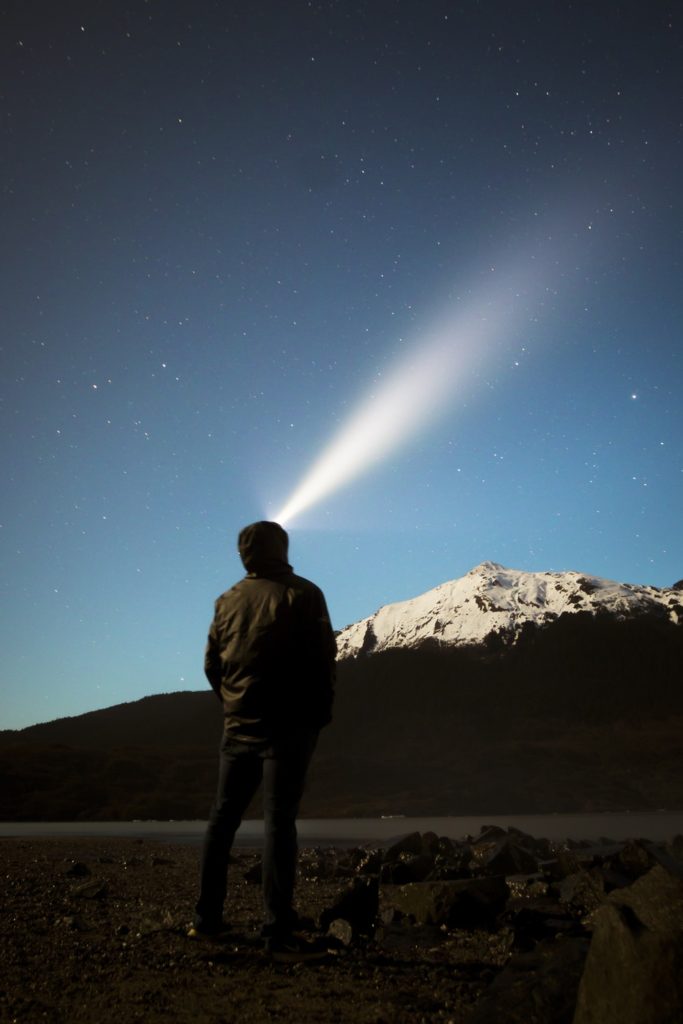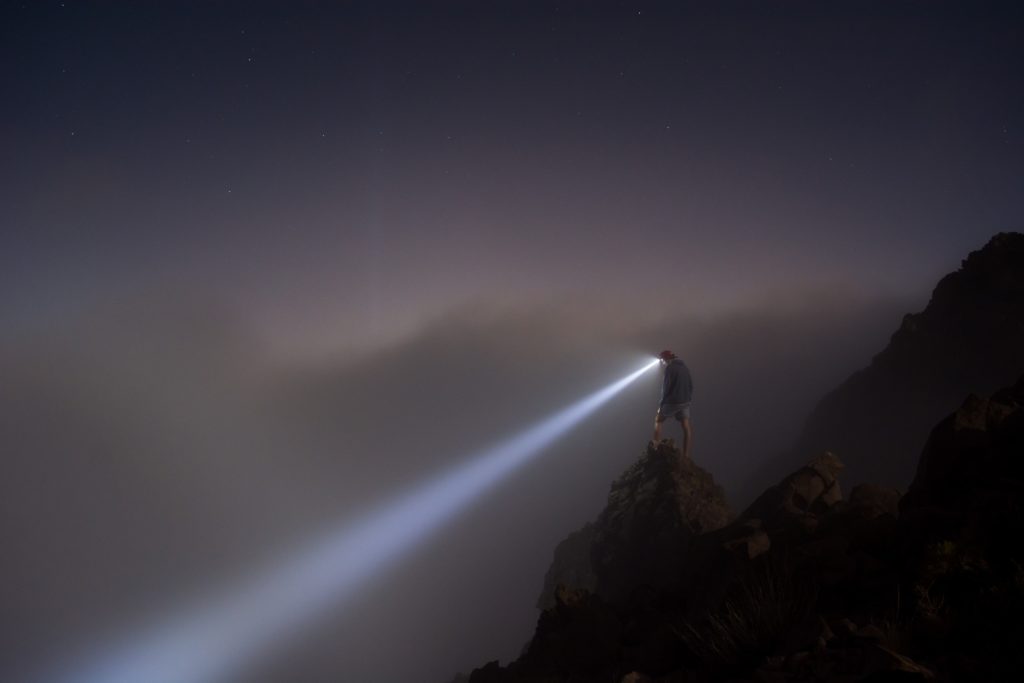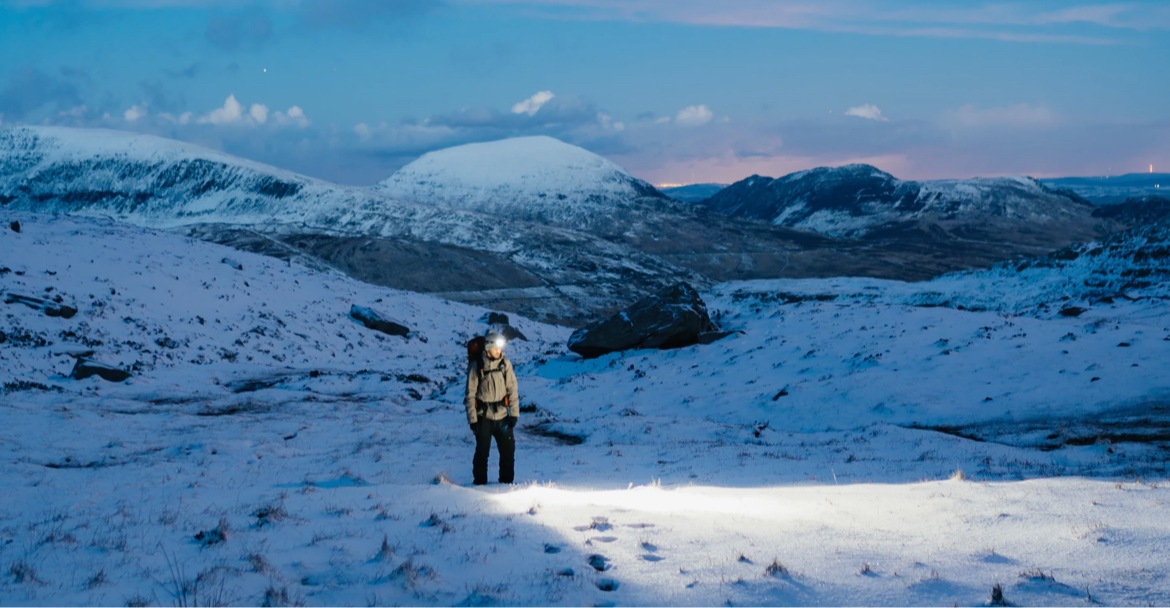After many hours of research, I’ve reviewed the absolute best headlamps for hiking, backpacking and trail running. Whether you’re looking for brightness, compact or support – one of the headlamps below is going to be the right fit for you.
I go straight into my headlamp reviews with direct product links beneath each review. Below the reviews, I dive into detail about beam shape and lumens if you’re interested in learning more about headlamp specs with my headlamp buying guide.
1. Black Diamond Spot 325
Best Overall Headlamp

The Spot 325 is the newest version of the famous Black Diamon range of headlamps. It’s a compact low profile design that’s both rugged and packed with different light modes.
You can cycle through strobe, red night vision, and high and low brightness with the gentle tap of a button (touch-sensitive ‘power tap’, rather than push down).
The headlamp projects a powerful 325-lumen beam at full capacity which is more than enough for any night time adventures even in the depths of a moonless night,
The Spot 325 is easy to adjust and fit comfortably with its’s low-profile design that weighs just 85 grams (3 oz.). The beam projects 80m and is powered by AAA batteries.
The headlamp is hard to beat with its balance of price, power, and durability – my only complaint is that there is no USB rechargeable version. If you’re looking for a no-fuss lamp that has all the modes you’ll need, has a powerful beam and is fully waterproof then your in safe hands with the Black Diamond Spot 325.
Awesome features worth mentioning:
- Incredible prices for a high powered 325-lumen beam which projects 80m.
- Weighs just 85 grams (3 oz.)
- Fully waterproof and can be submerged to 1.1 meters for 30 minutes – which means it can handle any weather and drops in mud or wading through rivers.
Downsides
- No rechargeable USB battery option.
Where to buy?
Best Rechargeable Headlamp
2. Petzl Actik Core
Straight out of the gate – the Petzl brand is world leaders in rechargeable headlamps and their new hybrid design with the core series allows you to swap out the battery back for AAA batteries. This is incredibly useful for multi-day trips when you need extra juice and for saving money on batteries.
The Petzl Actik Core is a top of the range headlamp with a powerful 350-lumen brightness when both white LED’s are activated. The 7 hour burn time (at full brightness) and easy micro-USB charging makes this a standout performer.
The Petzl is rated IPX water-resistance which makes it fine for rainy conditions but it won’t last if submerged in water – which is the only downside with the Petzl Actik.
The Actik core is not cheap, but it’s feature packed dual power option make this a highly attractive for outdoor adventurers looking for a reliable and powerful beam – that weighs in at 82 grams (2.9 oz). (If you’re happy to compromise on brightness for a cost-saving – see the Petzl Tikkina below)
Awesome features worth mentioning:
- 350-lumen output from two powerful white LEDs.
- Petzl Core dual power feature – USB rechargeable & AAA battery compatible.
- Powerful, ergonomic design.
- 3 brightness levels + red light mode.
Downsides
- Not as waterproof as the Black Diamond (Only water resistant).
- Not cheap (but worth it).
Where to buy?
Best Budget Headlamp
3. Petzl Tikkina Headlamp

The little brother to the Petzl Actic, the 150 lumen Petzl Tikkina is a cheaper, lighter (but less powerful) headlamp.
The Tikkinia is an incredibly cheap lamp for it’s offering. What I love about this – is that despite its low cost it is still compatible with the Core rechargeable battery (sold separately in this case).

Using AAA batteries you’ll get 220 hours on the lowest brightness setting or 80 hours on the highest setting. It has an adjustable angle which allows you to move the direction of the light beam and is great for camping, trekking and trail walks.
The center operated button makes it easy to cycle through the different light levels from the single white LED. The strap is comfortable to wear all day and weighs just two grams more than the Actix Core at 85grams (3oz).
If you’re looking for a budget option that’s lightweight, comfortable to wear and provided a decent level of light, then it’s hard to beat the Tikkina.
Awesome features worth mentioning:
- 150 lumens which is good enough for most activities in and around camp and the beam projects 50m.
- Compatible with Petzl Core rechargeable pack – sold here.
- 60-220 hours of burn time (high end at the lowest setting).
- Water resistant – fine for light rain.
- Directional hinge to point your beam where you want it to go.
Downsides
- No high powered brightness level.
Where to buy?
P.S if you’re looking for a bit more power (+50 lumens) see the Petzl Zipka.
Best Bright Headlamp
4. Coast FL85 Headlamp
If you’re looking for pure brightness and don’t mind draining your batteries fast then the Coast FL85 headlamp is for you. This headlamp delivers an impressive crazy bright 615 lumens of power and the focusing ring allows you to focus the beam into a small space and over an incredibly long distance – 182 meters (600 feet).
The powerful bulb comes at a cost of weight and battery life – but the price for the system is very affordable. The lamp weighs 127grams (4.5 oz) which is not too heavy for how bright the lamp is. Expect it to take up a bit more room in your backpack.
At full mode, the batteries will drain fast, but the lower modes are still nice and bright and great for lighting up the trail. What I love about this headlamp unlike many others on this list, is that the focusing ring allows you to change the shape of the beam from narrow to wide. This makes it perfect for lighting up an entire camp and for illuminating a something specific in the distance – like a wild animal.
If you’re looking for a high powered beam at a decent price which a precise beam focus ring – then the Coast FL85 is my top pick.
Awesome features worth mentioning:
- High powered 615 beam projects over 182 meters!
- Focus ring allows you to change the beam from narrow to wide in an instant.
- Comfortable strap and decent weight for the bulbs power.
- Reflective bands and red LED light.
Downsides
- 3 x AAA Batteries will drain in 2 hours at full beam – so only use it when you really need it. (lower modes will give you much more time).
Where to buy?
Best Headlamp for Running
5. Black Diamond Sprinter
If you’re a trail running nut and looking for a reliably bright headlamp that projects into the distance and stays securely on your head – then the Black Diamond Sprinter is a sure fire choice.
The Sprinter has a vertical as well has a horizontal strap which stops the headlamp from bobbing up and down while you’re working on your sprints or jogging up and down rocky trails.
What I love about the Sprinter is that it uses a USB rechargeable battery so you can charge it up and home or in your car and not worry about replacing pricey batteries. If your runs are under 24 hours then you’re covered.
The battery sits at the back of the strap to make for a more balanced and properly weighted fit. The headband has a reflective taillight and the single oval beam projects forward over a nice distance of the trail ahead.
Most other headlamps on this list can be used for the occasional run, but if you’re looking for more support and a better running beam then you can’t go wrong with the Sprinter.
Awesome features worth mentioning:
- 200 lumens for a bright light and a great 50m projection.
- USB rechargeable battery pack.
- 24 hours of battery life (average) or 42hrs (low brightness).
- 2-way strap for comfort and no movement while running.
- The battery sits at the back for an evenly weighted band.
Downsides
- Beam not great for close up view (lacks a focus ring).
Where to buy?
Best OF THE REST
6. Petzl Reactik+

Rather than a strap that goes over the top of the head, it uses a dual-band strap at the back for a secure fit that doesn’t feel uncomfortable. This is a great choice for trail running, camping, hiking and mountain biking.
The Reactik+ is my pick for the best of the rest and a great choice if you’re looking for a mix of power and comfort.
Awesome features worth mentioning:
- Washable headband with a sturdy secure fit.
- USB Rechargeable battery.
- Bluetooth allows you to control the light and check the battery charge precisely.
- Splash-proof makes it fine for trail running in the rain.
- Reacts to ambient light to adjust brightness on the fly.
Downsides
- Pricey.
Where to buy?
| Category | Headlamp | How much? |
|---|---|---|
| Best Overall | Black Diamond Spot 325 | Check Price |
| Best Rechargeable | Petzl Actik Core | Check Price |
| Best Budget | Petzl Tikkina Headlamp | Check Price |
| Best Brightness | Coast FL85 Headlamp | Check Price |
| Best for Running | Black Diamond Sprinter | Check Price |
| Best of the Rest | Petzl Reactik+ | Check Price |
Headlamp Buying Guide
- Brightness: How Many Lumens Do I Need?
- Light modes and why they’re helpful
- Battery Options: Do you have time?
- Bright, but for how long?
- Extending your battery life
- Weight
- Comfortable straps
Brightness: How Many Lumens Do I Need?
Every year headtorch brands are pushing the boundaries of power as batteries get more efficient and are able to project more power into the lamp.
Headlamp brightness is measured in lumens – generally the higher the number the brighter the lamp. However, there are some caveats to this; Some lamps cram these lumens into a very tight beam which makes it great as a spotlight but not so useful for a wider field of vision. Technically lumen is the measurements of how much visible light the lamp can generate, rather than how much they project.
 While looking for higher lumens is a good idea, it’s also worth taking into account if it impacts the battery life and the shape and size of the beam – some models will allow you to change the size and shape of the beam – and sometimes even the color balance of the light.
While looking for higher lumens is a good idea, it’s also worth taking into account if it impacts the battery life and the shape and size of the beam – some models will allow you to change the size and shape of the beam – and sometimes even the color balance of the light.
Many headlamps nowadays also have a variable setting which allows the lamp to consume different amounts of power and project a weaker or brighter beam. Most of the time it’s best to be on the low to medium beam while hiking so as to preserve battery. The brightest beam is usually great for more challenging conditions when you need maximum brightness and don’t mind sacrificing battery power.
Based on my testing I’ve found that 25-150 lumens is great for working around the house and yard and as a backup for backpacking, camping, and hiking. In complete darkness with no moon, you’ll want to be in the 200+ lumen range. If you’re moving at speed, such as mountain bike riding or night trail running then you’ll be able to see and react to the landscape more smoothly when you’re in the 250 lumen range.
Lumen is a great indicator of how bright a lamp is, but should not be the overall metric by which you judge how good a headlamp is. You’ll want to take into account the type of beam, the distance it projects and how long the beam will last for (battery life) as well as how adjustable the lamp is.
Light modes and why they’re helpful
Not every circumstance warrants the full bright beam of the headtorch and there are many times when a lower, wider or strobed beam is more useful.
LED
 One of my favorite features on my Petzl Zipka Headlamp is the red light mode which is great for reading at night time and providing enough light to move about in your tent – without glaring your eyes with unnecessary light when you’re ready to sleep. It’s also great for moving around sleeping friends and when you want to chat with someone and face them directly without blinding them. It uses a small led to project just enough light to help you see in a night-vision glow. It uses very little power and is a great backup to have.
One of my favorite features on my Petzl Zipka Headlamp is the red light mode which is great for reading at night time and providing enough light to move about in your tent – without glaring your eyes with unnecessary light when you’re ready to sleep. It’s also great for moving around sleeping friends and when you want to chat with someone and face them directly without blinding them. It uses a small led to project just enough light to help you see in a night-vision glow. It uses very little power and is a great backup to have.
Strobing
Many headlamps have a strobe setting which is great for use in an emergency or for signaling to other hikers. Most lamps have just one button that you press multiple times to cycle through the different modes which makes it easy to change brightness and preserve battery when full power is not needed.
Flood light
Another helpful feature to have integrated into your headlamp is the ability to change the size of the beam from focused to a flood light. This provides helpful wide-angle projection of light and makes moving in and around your camp and tent much easier.

Battery Options: Do you have time?
Most LED headlamps run on AAA batteries which are typically housed in the main body of the lamp or distributed in the strap. Other headlamps are only rechargeable while some models like my Petzl Zipka have the option of using both rechargeable or a more standard battery pack.
AAA Batteries
AAA batteries tend to provide more power than rechargeable battery packs and last longer. The downside is that the batteries are disposable and the costs add up over time. The major advantages are that they last longer and you can more easily have a ready supply of them as backups. Eventually, when technology catches up rechargeable options will be as powerful as and last longer than typicaly battery setups.
Rechargeable
Rechargeable lamps are arguably more environmentally friendly and the ability to re-use the same battery is a bonus in many scenarios. The problem is that the battery does not usually last as long and when you’re out in the backcountry – recharging them when they go dead is not possible unless you happen to have a solar charger or a nearby car with a converter to micro-USB.
Still rechargeable batteries and getting better and better each year and as they become more efficient their unique advantages are outshining the drawbacks.

Best of both worlds – Petzl Hybrid
As I touched on earlier, the ideal setup is the Petzl hybrid feature which gives you the option of using a rechargeable CORE pack and the ability to remove it and use AAA batteries – this gives you the best of both worlds.
You get all the benefits of easy to find batteries – which you can bring as backups for a longer multi-day camping trip. You can fully charge your pack at home and rely on this until it runs out and then switches over to batteries.
You’ll pay a bit more for this privilege but it’s well worth the extra expense if you’re finding that a single rechargeable battery isn’t giving you the juice you want or you’re not happy to rely just on AAA batteries – the costs of which can add up over time.
Bright, but for how long?
 Often the advertised battery life relies on a gradient lumen output – whereby as the battery power diminishes so does the overall lumen output. For most scenarios, this is advantages as it helps stretch out your battery life – but be warned it does make the advertised battery life misleading.
Often the advertised battery life relies on a gradient lumen output – whereby as the battery power diminishes so does the overall lumen output. For most scenarios, this is advantages as it helps stretch out your battery life – but be warned it does make the advertised battery life misleading.
If you’re expecting that same great lumen output from the first minute you turn on the lamp to its last minute of battery juice – then you will likely be disappointed.
The one exception to that rule is the Petzl Actix Core which will pump out its maximum lumen output at a near constant rate until the entire battery is spent – it will then go dark quite quickly.
It’s not easy to find the manufacturer specs for how the brightness of the lamp changes over time, but if you can search out charts that list the lumen level alongside the battery runtime. Another way is to find the manufacturers quoted spec for the maximum time that the beam is projected at its highest output.
Extending your battery life
The best way to extend your headlamps battery is to only use it when you need it. Sounds simple but by making sure you’ve only got it running on its maximum setting when it needs to be will go along way to preserving juice.
Most of the time, the second or third level of brightness will be sufficient for most tasks at dusk or in moonlight. It’s only in extreme darkness or when moving at speed that having a brighter light is worth the extra battery power.
It’s better to have some light when you need it rather than excellent lighting and then suddenly none- if you run out of battery life before your trip is over.
In very cold weather the battery life can diminish faster, so it’s worth keeping your battery in your inside jacket pocket
Weight
Compared to your backpack your headlamps weight is not significant, but because it sits directly on your head a small weight saving can and does have an effect (if minor) on neck strain the duration of long days of trekking.
While many headlamps are compact and lightweight, there is quite a range from the Petzl +Lite that’s just 27grams (0.95 oz) to the heavyweight Princeton Tec Apex Extreme 416gram (14.7 oz).
Weight saving will impact battery life and durability. Lighter models are made from thinner plastic casing and have less space for batteries. Heavier options use thicker plastic or aluminum for a more rugged lamp that can withstand drops and bumps and will generally have more batteries for increased power output and brightness. Heavy lamps take up more space and are and can be less comfortable to wear – looks for lamps with extra padding for their weight.
While most headlamps house the battery pack behind the lamp head at the center, some lamp systems distribute weight by having battery compartments around the strap. These help counter-weight the front of the torch and provide more power but in some cases can be more uncomfortable – but it does depend on the design.
Weight becomes important if you’re moving your head frequently, like when mountain biking or trail running. In these cases, a heavier lamp will make a noticeable difference and can become annoying if it’s bouncing up and down as you move.

Comfortable straps
Strap design plays an important role in how comfortable a headlamp is and can make a massive difference over the lifetime of its use. While every headlamp has adjustable straps there are two main types.
2-piece strap systems are more secure and provide a tighter fit for more movement – great if your out adventuring on the mountain; rock climbing, caving or mountaineering. The strap covers your head in two directions and are pretty straightforward to use.
One piece straps are the most popular option for most headlamps and they provide a secure fit for most activities like day hiking and camping. It’s simple and does the job.








